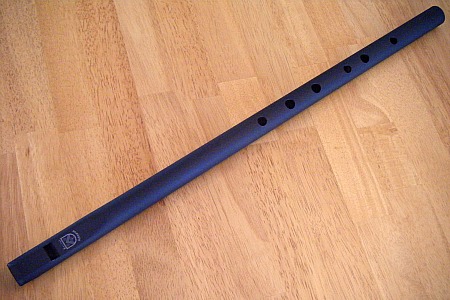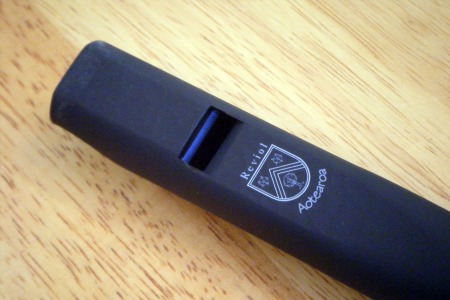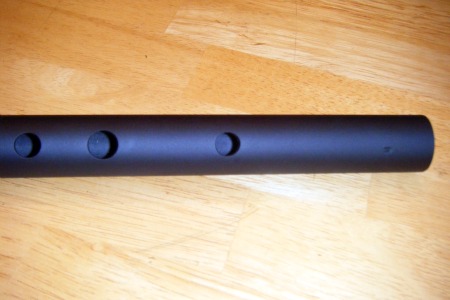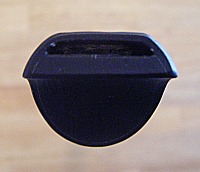Maker - Reviol Woodwinds (Maurice Reviol) www.reviol.co.nz
Material - Anodized Aluminum
Dimensions: Length - 22 3/4ths"
Distance between 1st and 3rd bottom holes - 3"
Diameter of 2nd hole from bottom - 7/16ths"
Bore - 7/8ths"
Weight - 6.5 oz
Price at time of review - Tunable low D whistles were going for 400 NZ$ (around $300 USD) direct from maker. Non tunables were not priced on the makers website but it did state they could be custom ordered, I assume they would cost slightly less.
Maurice
Reviol learned to make low whistles from Cillian O' Briain (whose
whistles are now quite sought after as he stopped making them awhile
ago). Maurice originally made and repaired bassoons, but after meeting
Cillian, he started making whistles and Uilleann (irish) pipes and
eventually moved on to making wooden flutes, which now seems to be his
main focus. At the time of this review he was making low whistles in
the keys of C, D, Eb, E, F and G, and you could also order sets with
interchangeable heads. I bought the whistle reviewed here from the Irish Flute Store, but I also did
at one time own a C, D, Eb tunable set that I bought direct from
Maurice. He seemed an excellent chap and responded to all my emails
promptly.








Appearance:
The first visually noticeable thing about this whistle is of course that it is black (Reviol makes them in either black or silver) as it is anodized. But unlike other anodized whistles that I have seen, it is a matte black with a slightly rough, almost sandpaper like texture to it's surface which makes for a great no-slip grip, unlike
anodized whistles like MKs and Goldies which are shiny and polished but
can also sometimes be slippery or slick to hold. The only thing
relieving the all black exterior is a white crest placed under the
window with the words "Reviol" and "Aotearoa", which is the
Maori name for "New Zealand", which is of course where Maurice
resides. (The Maori are the native people of New Zealand) One of the
coolest visual aspects of this whistle however seems to be almost
impossible to capture in a photo, which is this great scalloping
texture on the top of the whistle on the mouthpiece and around the
window. This is caused by the fact that this area is hammered into
shape by hand, leaving hundreds of little hammer dents, very awesome
effect! The underside of the mouthpiece has a much longer undercut or
slope compared to other low whistles, which I found to be quite
comfortable, as the bottom of the whistle did not hit my chin when
playing. The top finger hole
(the one closest to the mouthpiece) was slightly larger than it is on
most other whistles, but this didn't seem to cause a problem, it just
felt a little weird. One last note worthy aspect is the size of the windway, being one of the largest/tallest windways I have seen on a low whistle. Overall the whistle is very well made and shows expert craftsmanship, especially when you consider it is handmade.
Tone: I love the tone of this whistle. To me, it is the closest I have heard a low whistle come to sounding like a wooden flute played in the Irish style. The top octave is pure and sweet while the bottom has a great undercurrent "growl", and overall the whistle has just the right amount of breathiness to imitate a wooden flute. The low fundamental note is surprisingly resonant considering the air requirement (see below).
Volume: I would describe the volume of this whistle as being moderate to loud in comparison to other Low D's I have played. It is fairly well balanced between octaves, with even the low register being surprisingly loud considering that you have to back off breath wise to keep the bottom notes from jumping into the second octave.
Backpressure/air requirement: Most likely due to it's large windway, this whistle has very little backpressure, which causes it to have a higher than average air requirement. This also unfortunately caused the bottom few notes to be a bit more touchy then I would like, as they can jump or break easily. This was not an insurmountable problem, and can be adjusted to without too much practice. The fact that this did not effect the volume or resonance of the fundamental note also helped to keep this from being a deal breaker as it were.
Responsiveness: This whistle is nicely responsive, although it is not as responsive as say an MK or a V3. Ornaments are quick and by no means sluggish, with about an average level of snap.
Clogging: I had no clogging issues with this whistle, again most likely due to it's large windway.
Tuning: This whole whistle was very well and pleasantly intune with itself. However the whole thing was also about ten cents sharp from A440 tuning, most likely due to the differences in climate and atmosphere between where it was made and where I am. This of course would not be an issue at all if it was tunable, so is not a bad reflection on the craftsmanship of the whistle. The C natural played well with the OXXXOO fingering.
Summary: The only thing, and I do mean the only thing, that kept me from giving this whistle all six holes was that the bottom few notes were just a little too touchy and easy to break. I did find the high air requirement to be an issue personally, but where backpressure is an individual preference, I try not to hold it against a whistle in general. Otherwise I loved this whistle, especially the tone. Five holes!

Tone: I love the tone of this whistle. To me, it is the closest I have heard a low whistle come to sounding like a wooden flute played in the Irish style. The top octave is pure and sweet while the bottom has a great undercurrent "growl", and overall the whistle has just the right amount of breathiness to imitate a wooden flute. The low fundamental note is surprisingly resonant considering the air requirement (see below).
Volume: I would describe the volume of this whistle as being moderate to loud in comparison to other Low D's I have played. It is fairly well balanced between octaves, with even the low register being surprisingly loud considering that you have to back off breath wise to keep the bottom notes from jumping into the second octave.
Backpressure/air requirement: Most likely due to it's large windway, this whistle has very little backpressure, which causes it to have a higher than average air requirement. This also unfortunately caused the bottom few notes to be a bit more touchy then I would like, as they can jump or break easily. This was not an insurmountable problem, and can be adjusted to without too much practice. The fact that this did not effect the volume or resonance of the fundamental note also helped to keep this from being a deal breaker as it were.
Responsiveness: This whistle is nicely responsive, although it is not as responsive as say an MK or a V3. Ornaments are quick and by no means sluggish, with about an average level of snap.
Clogging: I had no clogging issues with this whistle, again most likely due to it's large windway.
Tuning: This whole whistle was very well and pleasantly intune with itself. However the whole thing was also about ten cents sharp from A440 tuning, most likely due to the differences in climate and atmosphere between where it was made and where I am. This of course would not be an issue at all if it was tunable, so is not a bad reflection on the craftsmanship of the whistle. The C natural played well with the OXXXOO fingering.
Summary: The only thing, and I do mean the only thing, that kept me from giving this whistle all six holes was that the bottom few notes were just a little too touchy and easy to break. I did find the high air requirement to be an issue personally, but where backpressure is an individual preference, I try not to hold it against a whistle in general. Otherwise I loved this whistle, especially the tone. Five holes!